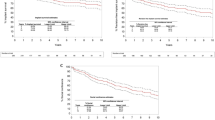Abstract
The objective of this study was to identify sonographic parameters that could predict sucessful outcome in women after periurethral collagen implant. Thirty-one women with a diagnosis of stress urinary incontinence with intrinsic sphincteric deficiency underwent one periurethral collagen implant between January and December 1994. Three months after the procedure ultrasound evaluation was performed using a 5 MHz probe placed at the vaginal introitus. Subjective assessment and cough stress test were used to measure outcomes. Twenty-five women were available for evaluation 1 year after the procedure. A successful outcome was found in 18 of the 25 women subjectively (72%) and in 16 objectively (64%). A distance of the collagen from the bladder neck of less than 7 mm was found to be associated with a positive outcome. This threshold was found to have a sensitivity of 83.3%, specificity of 85.7%, a positive predictive value of 93.7% and a negative predictive value of 66.6%.
Similar content being viewed by others
References
Wan J, McGuire EJ, Bloom DA, Ritchey ML. Stress leak point pressure: a diagnostic tool for incontinent children.J. Urol 1993;150:700–702
McGuire EJ, Fitzpatrick CC, Wan J, Bloom D. Clinical assessment of urethral sphincte function.J Urol 1993;150:1452–1454
Appell RA. Collagen injection therapy for urinary incontinence.Urol. Clin North Am 1994;21:177–182
McGuire EJ, Appell RA. Transurethral collagen injection for urinary incontinence.Urology 1994;43:413–415
Sachse S. Treatment of urinary incontinence with sclerosing solutions. Indications, results, complications.Urol Int 1963;15:225–244
Politano VA, Small MP, Harper JM, Lynne CM. Periurethral Teflon injection for urinary incontinence.J Urol 1974;111:180–3
James MJ, Iacovou JW, Lemberger RJ, Kockelbergh RC. A one year follow up of periurethral silicone for simple stress incontinence. Annual Meeting of BAUS, Harrogate 1993
Gonzales de Garibay AS, Castillo Jimeno JM, Villanueva Perez I, Figuerido Garmendia E, Vigata Lopez MJ, Segastian Borruel JL. Treatment of urinary stress incontinence using paraurethral injection of autologous fat.Arch Esp Urol 1991;44:595–600
Dairiki Shortliffe LM, Freiha FS, Kessler R, Stamey TA, Constantinou CE. Treatment of urinary incontinence by the periurethral implantation of glutaraldehyde cross linked collagen.J Urol 1989;141:538–541
Monga AK, Robinson D, Stanton SL. Periurethral collagen injection for genuine stress incontinence: a 2-year follow-upBr J Urol 1995;76:156–160
Metz CE. Basic principles of ROC analysis.Semin Nucl Med 1978;8:283–298
Abrams P, Blaivas JG, Stanton SL, Andersen JT. Standardization of terminology: the standardization of terminology of lower urinary tract function recommended by the International Continence Society.Int Urogynecol J 1990;1:45–48
Mittleman RE, Marraccini JV. Pulmonary teflon granulomas following periurethral teflon injection for urinary incontinence.Arch Pathol Lab Med 1983;107:611–612
Aaronson IA, Rames RA, Green WB, Walsh LG, Hasal UA, Garen PD. Endoscopic treatment of reflux: migration of teflon to the lungs and brain.Eur Urol 1993;23:394–399
Khullar V, Cardozo LD, Abbott D, Hillard T, Norman S, Bourne T. The mechanism of continence achieved with GAX collagen as determined by ultrasound.Neurourol Urodyn 1993;12:439–440
Author information
Authors and Affiliations
Additional information
EDITORIAL COMMENT: We know very little about why collagen injection at the bladder neck works or what makes it produce continence, especially in the long term. The height of the ‘bumps’, the location of the injection as determined by ultrasound, and finally the degree of vascularization of the material may all be important. Further studies are needed to elucidate these points in greater detail, especially at 1 year or more. It is difficult in this study to determine whether the patients had a well supported bladder neck, as the results of the Q-tip test are not given: Q-tip results should always be reported in terms of degrees from the horizontal, as a angle change of 60°–70° is only 10° and could indicate hypomobility. But isn't a resting angle of 60° from the horizontal already indicative of urethralhypermobility? As a final point, we know that Valsalva leak-point pressures are useful in determining the need for collagen injection in patients with ISD and urethral hypermobility, and that a value of less than 65 cmH2O has validity. Where does the new figure of 100 cmH2O fit in, as was recently announced by the manufacturer of the collagen implant? Valsalva leak-point pressure usefulness in selecting other forms of surgical procedures for continence remains to be proven, and this test should not be given the same significance as low urethral close pressure, whose clinical predictive value is well established, when other surgical procedures are considered.
Rights and permissions
About this article
Cite this article
Elia, G., Bergman, A. Periurethral collagen implant: Ultrasound assessment and prediction of outcome. Int Urogynecol J 7, 335–338 (1996). https://doi.org/10.1007/BF01901110
Issue Date:
DOI: https://doi.org/10.1007/BF01901110




